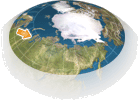 |
Impacts of petroleum
exploration and reindeer grazing on ecosystems |
| |
Many direct and indirect impacts (e.g.,
poaching, as described above) occur as a result of petroleum exploration.
After more than 25 years of exploration, the tundra ecosystems of
northwest Siberia are characterized by many of the same impacts
found in arctic Alaska (cf. Reynolds and Tenhunen 1996; Walker 1997).
On Yamal, these impacts are documented by Forbes (1995, 1997), Khitun
(1997) and Vilchek (1997). Natural disturbances which regularly
create large areas of bared mineral soils include thermokarst erosion,
lake drainage, and so-called 'shallow-layer detachment slides',
when large portions of slopes slump downhill and reveal bare mineral
soils (Leibman and Egorov 1996; Pavlov 1997). The region is vast
and the amount of overall industrial disturbance seems small when
calculated as a percentage of the total land area (Vilchek 1997).
Nonetheless, as Nenets are quick to point out, the developers always
take the best lands - higher, drier ground - for creating infrastructure
(Alexander 1994; Forbes pers. obs.) (Fig. 2). In an area as flat
as Yamal, dominated by mires and lakes, this quickly puts additional,
unsustainable pressure on the remaining relatively high ground,
such as ancient sand dunes, which is exploited by the reindeer for
insect relief in summer (Helle and Aspi 1984). |
| |
Reindeer grazing impacts are documented
by Podkoritov (1995), Korytin et al. (1995), Martens et al. (1996)
andMagomedova et al. (1997). Reindeer greatly affect community structure
and productivity via their trampling and grazing. For example, cover
of virtually all lichens, especially those fruticose species most
preferred by reindeer (Podkoritov 1995), is minimal and ruderal
or weedy species are prominent (Forbes 1995). There is evidence
that vascular ruderals, which are normally restricted to disturbed
habitats, have begun to spread into relatively 'intact' tundra,
where the organic layer has been thinned often to the point of rupturing
from trampling by the animals (Forbes and Jefferies 1999). The cover
of grasses, in particular, is increasing in many areas - so-called
'grassification' - at the expense of dwarf shrubs and lichens (Martens
et al. 1996). Grazing is increasingly conducive to the formation
and expansion of denuded soil, particularly in zonal dwarf shrub-lichen
tundras on sandy substrates, where denudation triggers deflation
processes (Martens et al. 1995; Khitun 1997; Vilchek 1997). The
cumulative impacts associated with grazing thus include: greatly
accelerated deflation of exposed sands; thinning, warming and cratering
of the vegetation mat; increased infiltration rates resulting in
massive thermokarst and landslides; and altered hydrology and drying
of soils in drained areas. It is estimated that 70% of the pastures
currently belong to the low quality category (Korytin et al. 1995). |
| |
Reindeer herders of the state farm
(or Sovkhoz) "Yarsalinskii", which manages those reindeer
herds grazing in the vicinity of the Bovanenkovo Gas Field, have
for many years been violating the Sovkhoz's borders by allowing
their animals to graze extensively on pastures administered by the
more northerly state farm "Yamalskii". Actions such as
this are conducive to furthering the conflicts between reindeer
herders working for the state farms and those acting as private
owners/herders. These violations appear to start a chain reaction,
leading to more violations (Okotetto and Forbes 1999). A parallel
situation has been reported by Evdokimova (1999) slightly further
west on the Bolshezemelskaya tundra, where pastures have been similarly
degraded due to competition between Nenets and Komi herders for
the same grazing land. |
|
